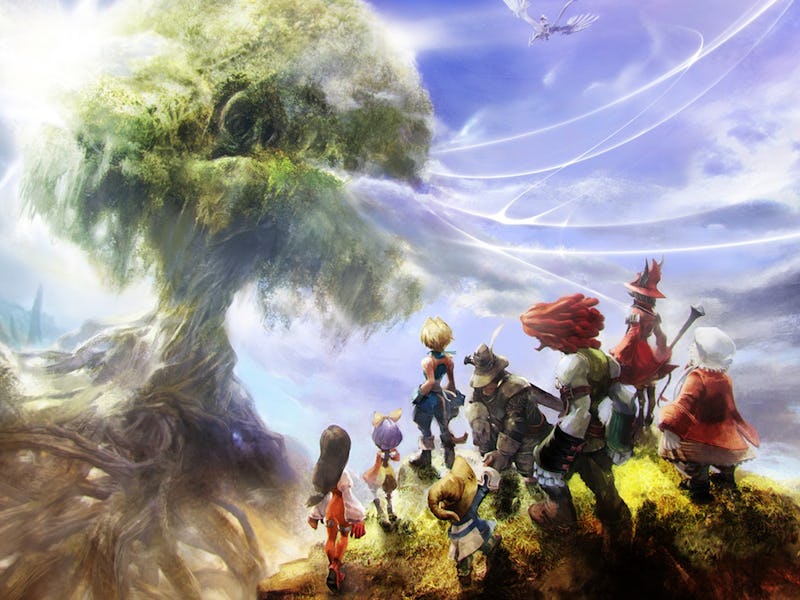
Final Fantasy 7 is a pivotal piece of art, one of those handful of titles that forever changed the trajectory of the gaming industry. A darker, edgier narrative with complex, conflicted heroes, it was a seismic shift in design and tone. That precedent carried forward into countless RPGs, including the next Final Fantasy, which is why it was so shocking when the gritty techno stories of Final Fantasy 7 and 8 yielded to the classical stylings of Final Fantasy 9.
This complete shift produced one of the series’ most impactful entries, which came out 25 years ago today. A fusion of Final Fantasy past and present that weaved complex storytelling with the franchise’s core tenets, Square created the purest version of what it means to be a Final Fantasy game.
Final Fantasy 9’s distinct backgrounds look painterly and abstract.
Final Fantasy 9 has the three elements inherently important to any game in the franchise: strong systems, a compelling ensemble cast, and a sense of whimsy. That last one might seem odd, especially in the context of a video game. But there’s a kind of nostalgia that radiates from a good Final Fantasy game, a warmth you can feel in your chest.
Even the darkest instalments have that quaint sense of humor. In Final Fantasy 16, we see Clive excitedly recite a play from his childhood. Final Fantasy 7 has a slapstick section where the party trudges up 70 flights of stairs. Final Fantasy 15 lets you take pictures of the grinning bros helping Noctis pull a monstrous fish out of the water. Those light moments are essential, and Final Fantasy 9 honed that whimsy to a sheen.
Final Fantasy 9’s tone is immediately set by its whimsical opening play.
Final Fantasy 9 isn’t an unserious game; it has some of the franchise’s darkest moments, and explores weighty themes of life, existence, and purpose. The story’s cheery veneer is juxtaposed against those themes, and the game gets you invested in its world with whimsy. Final Fantasy 9 starts and ends with a play, creating a coy thematic loop bolstered by every element of the game.
The game has a painterly look to it, as gorgeous watercolor backgrounds mesh with evocative and often weird character models, like the long-tongued Quina or the fiery-haired Amarant. On a visual level, Final Fantasy 9 feels light and evocative, reminiscent of classic fantasy illustrations. There are so many whimsical details and mechanics; Moogles save your game using a quill and a massive book, while Steiner’s armor creaks and clanks every time he moves. Every aspect makes the world feel charming, which drives home the game’s theme of fighting for the beauty of life.
This is then perfectly complemented by the game’s robust cast. Every party member has a story that plays out alongside the main narrative, with the threads all coming together into one cohesive message. Vivi’s questioning of his existence ties into Freya’s conundrum of being forgotten by her loved ones, which ties into Zidane’s crisis of finding worth beyond his assigned purpose. It’s one of the series’ richest, most dynamic casts, particularly because of the emphasis put on the relationships everyone builds, not just how they relate to Zidane as the hero.
The ATE system helps make Final Fantasy 9’s story feel more far-reaching than any other entry.
The Active Time Event (ATE) system helps Final Fantasy 9 soar to even greater heights. Throughout the story, you’ll get pop-ups offering story vignettes that dive into what’s happening around the world outside of your quest. You get to see how your old crew is managing, what the villains are up to, and how party members are faring when you split up. It’s a brilliant system that enlivens the narrative. You aren’t just seeing events from the party’s perspective; you're seeing how the world reacts and adjusts to you. It’s a shame the franchise never revisited the mechanic.
The final piece of the puzzle is Final Fantasy 9’s progression systems, which also hearken to the series' roots. While the game doesn’t ostensibly feature a job system, the idea of “jobs” is integrated into the character design. Vivi is the Black Mage, Zidane the Thief, and so on. This also highlights everyone’s quirks: Zidane’s Protect Girls skill reveals his problematic view that he always has to be a white knight, while Vivi’s doublecast represents his budding confidence in his own abilities.
Combat strategy comes from how you create cooperation between the jobs of each party member. This is given an extra layer of depth with the game’s equipment system, where characters learn skills from specific pieces of equipment. This allows for a lot of depth and synergy in your party builds, and it would inspire Lost Odyssey’s ring system, which in turn inspired the Pictos system of this year’s smash hit, Clair Obscur: Expedition 33.
Final Fantasy 9’s flexible skill system inspired quite a few other RPGs over the years.
The way Final Fantasy 9 interweaves all of these elements is what really makes it special. The game’s systems reinforce the complexity of each character, who thrive amid the game’s whimsical world. Each element works in harmony to make the game more than the sum of its parts. And that’s what Final Fantasy is all about: a confluence of narrative, themes, and systems that produce something unforgettable.
Final Fantasy 9 integrated the franchise’s roots with the innovations of 7 and 8, creating what feels like the definitive entry. It’s a game emblematic of the unique spirit of adventure and innovation that turned Final Fantasy into such an enduring franchise, and no other entry has quite been able to capture it since.